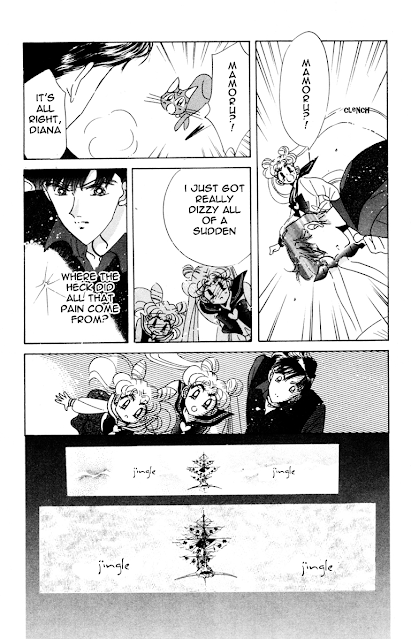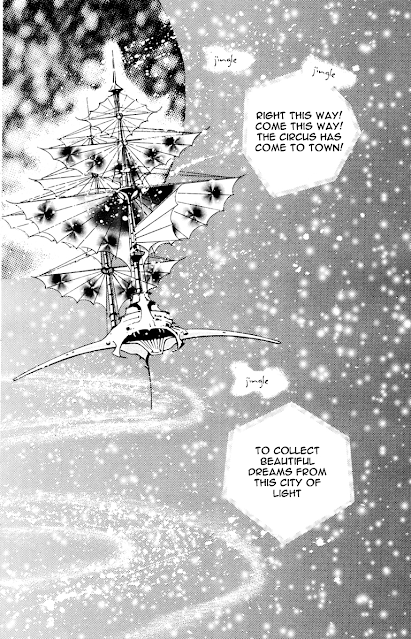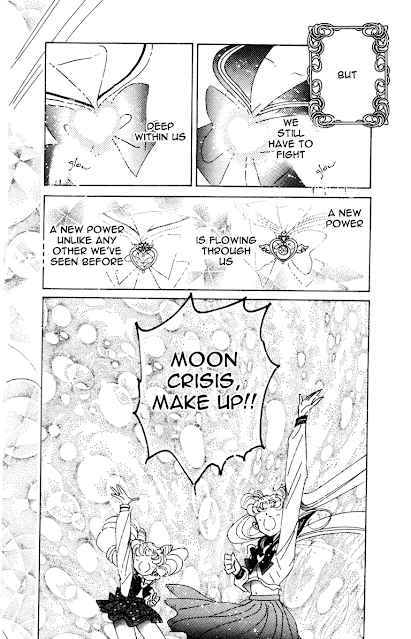It amazes me that I never hear anyone talk about this part. Yeah, it's weird, obscure, and doesn't come back up but that just makes it seem more conversation-worthy in my eyes. Where did this come from? Is this just another way from Naoko of making things seem surreal? I can't think of any other reason for this plot point to just suddenly be there.
With their new weapons, Super Moon and Super Chibi-Moon use the new attack of the arc, Moon Gorgeous Meditation. One thing I will definitely give this arc is it has on average my favorite attacks for the Senshi of any arc. The Quartet teleport away in fear and... I guess the tiger is also teleported away? Mamoru finally catches up to them but collapses much to Moon and Chibi-Moon's worry. Helios briefly shows up and the nearly unconscious Mamoru comments that he sounds familiar...
Back with the villains, Zirconia comments in annoyance and fear that the great light they faced must mean the people of the Moon Kingdom have been reincarnated, She angrily yells at the Quartet to stop messing around with flashy tricks, that the queen, Nehelenia, is angry.
Zirconia exposits to the Quartet about the White Moon Kingdom, implying she was around during the time of the kingdom but the Quartet were not. She explains that they have the infinite power of the holy stone (The Silver Crystal), and immortal bodies. Because of that, if they attack head-on, the Senshi will blow them away. As such, they must infiltrate slowly if they want to take the planet. This is a different dynamic than normal. Usually in this type of story, the villains are stronger, but here the villains outright acknowledge they are weaker and that they'll get crushed in a direct fight.
Zirconia goes and begins speaking to a mirror, commenting she wants to know of the horse that came to the Senshi's aid. Meanwhile, the Quartet begin complaining to each other, with Jun-Jun complaining that the "old hag" said she could do whatever she wanted, but is now telling her what she can do. Cere-Cere says she agrees with the hag, they only just got there, they should take advantage and have a little fun. Palla-Palla agrees, saying she wants to find out what kind of town this is and what kind of people are here. Ves-Ves gets an idea from this and gets three of their circus animals; a hawk, a fish, and the previously seen tiger. Palla-Palla uses her magical orb on them, turning them into the miniboss squad known as the Amazon Trio.


I have to be honest, I think this was perhaps a bit of a mistake on Naoko's fault. She's already introduced enough villains for this arc and is clearly struggling to express different personalities for the quartet given how their previous discussion didn't clearly differentiate their personalities and now she's just throwing in three more disposable villains. Also just to clarify; Naoko has made it apparent that the Amazon Trio are all male in the manga, even if one is a crossdresser. While the anime potentially made Fisheye transgender, in the manga, there's no indication Fisheye is female so I use male pronouns for manga Fisheye.
Ves-Ves gives their new minions their mission; they're gonna bring their lemure across town so that they can do what nightmare clumps love to do; eat beautiful bright dreams. She explains this is for the purpose of filling the town with dark dreams instead... because of course that explains it. That's a natural goal to just accept. The Amazon Trio express their understanding in ways to give slight understanding to their personality, with Tiger's Eye mentioning wanting to be an artist, Hawk-Eye teasing Ves-Ves by calling her their "big sister" before clarifying she's not old, and Fish Eye giving a comedic yell at the end of his declaration he will work really hard.
The quartet gather together to look into the dreams of their enemies where Usagi and Chibiusa are expressing the opposite sentiment of what they explained earlier with Usagi stating she has to be strong and mature and Chibiusa in fear expressing she doesn't mind being a kid, that she needs more training. Palla-Palla comments that throughout history the words of people contradict what they desire and while Usagi and Chibiusa fret over Mamoru, Palla-Palla uses her magic orb to reverse their ages.



I think Naoko does a generally good job of using her first act of each arc to express what the arc is going to be like, with the sole exception really being the first arc. With that said I'm not especially fond of this act, not necessarily because of its content but how long it is, and broadly unnecessarily so. This act is the same length as the first act of the third arc but that act was a slow burn building up the atmosphere around the Outer Senshi and the daimon and didn't actually contain that many plot points. This act actually contains a LOT of plot points. It introduces Zirconia, all the Quartet, the Amazon Trio, basically reintroduces Helios and his plot thread, has an episodic fight, has exposition on the mirror universe, has exposition on the eclipse, has a whole bunch of character moments, introduced the conflict for next chapter with two scenes devoted to it, etc. If you compare the section where I go over Act 27 it's 3,373 words, compared to this act's at 4,305 and that's because there were so many more plot elements I had to describe. I feel like this could have been better if Naoko had divided it into two acts.
Going into the actual content of the act, Act 39 is a general set-up for the Dream Arc, the same way 15 and 27 were for the Black Moon and Mugen Arcs, introducing the major elements and atmosphere. It's a surreal act with really strange things happening all over; but not arbitrarily strange. Everything that happens are either elements common in children's stories specifically or a creepy subversion of the prior. This arc is about Chibiusa's struggle to become a full Sailor Senshi, and in the same way that the Mugen Arc was about the mature, cynical Outer Senshi causing the arc to be dark and maturely sophisticated, this causes the Dream Arc to adopt a lot childish imagery either to play it straight or to subvert it to reflect a child's development.
I'm not very much a fan of this act's content, by Sailor Moon standards at least, because it just feels less than the sum of its parts. The same way Act 1 was filled with symbolism, Act 15 was filled with life, and Act 27 was filled with intrigue, Act 39 is filled with ideas. And it's not even necessarily that the ideas don't come together, because they do all support the surrealist atmosphere Naoko is going for. Things do indeed feel-dream like. It's that the overall results feel like less than the sum of its parts. This act includes some really cool ideas; the eclipse, Helios taking Chibiusa through the dream world, the Quartet sealing up the entrances, Zirconia acknowledging they're outclassed in a straight fight, Lemure being nightmares incarnated, the Senshis' weapons coming to life, yet in spite of the large size of the act, none of these individual ideas are given much focus. As a result, you don't know what here is especially important, as it doesn't seem to focus on anything else. That's a broad way I would describe a lot of the arc; it's atmospheric and is full of ideas, but it lacks a clear narrative focus for much of it.
That's obviously not to say the act is without redeeming factors, just that it's not one of my favorite SM acts. This act introduces a lot of the relatively unique aspects of the Dream Act; villains like the Quartet without much paralleling, more playful powers that aren't just insta-win buttons, the simple but beautiful childish imageries of things like flying on a magical pegasus and more. There's also a lot of cute interactions between the Lunar family and I especially liked the moment where Palla-Palla proclaims that for all of history, people have said the opposite of what they wanted for being a very archetypal line. And of course, I like the sequence of Chibiusa flying on Helios through the dream world, it's a sequence that's in most versions of Sailor Moon that reach the Dream Arc, because it's such an iconic sequence that captures what the Dream Arc can do at it's best; iconic imagery that carries the potential beauty of childish simplicity, unmoored in unnecessary complication.
Probably the best part of the act and the part that hits most in the mutual protective love between Usagi and Mamoru have for Chibiusa and her admiration of them, her parents. In the highly surrealist world made by this act, it's the most grounded relatable aspect. However, the worst aspect of the act is probably a sheer lack of narrative focus. Surrealism is not really my taste, but even beyond that I don't like the meandering feel of the act. In both aspects; this act is like a child; sweetly innocent, filled with infinite potential, but shifting in identity and concerns from moment to moment, hard to keep up with. How much you like it, I imagine depends on how much you value that childishness.































































